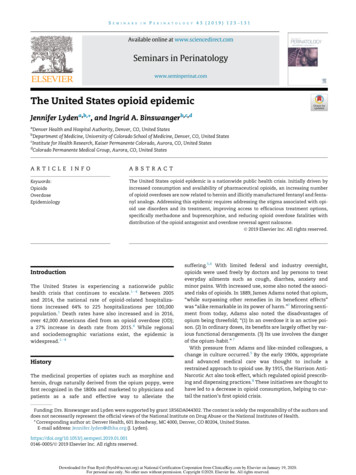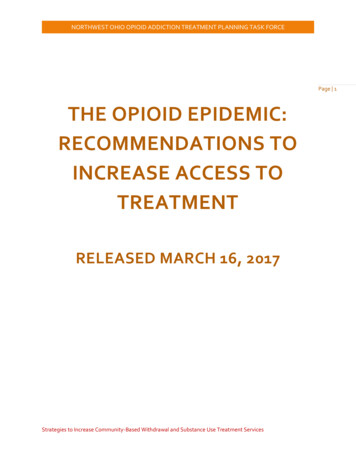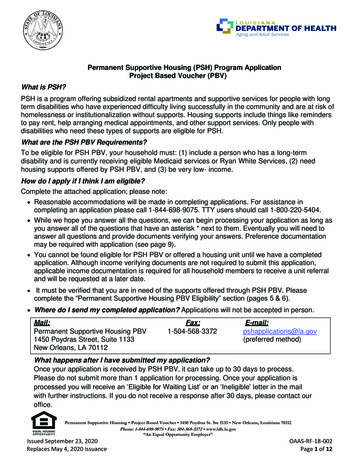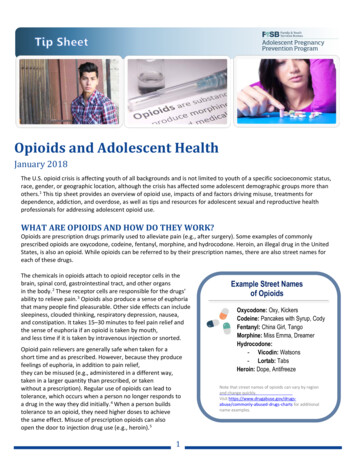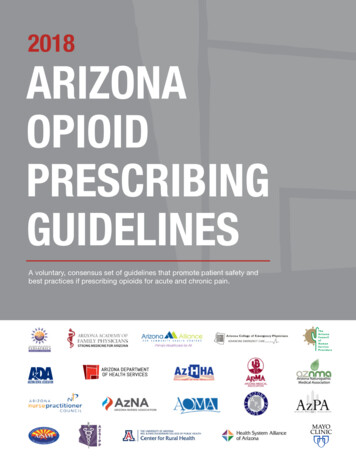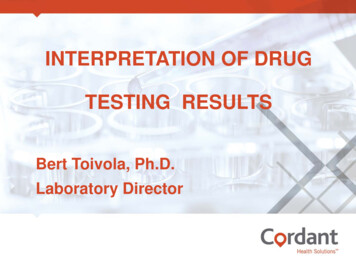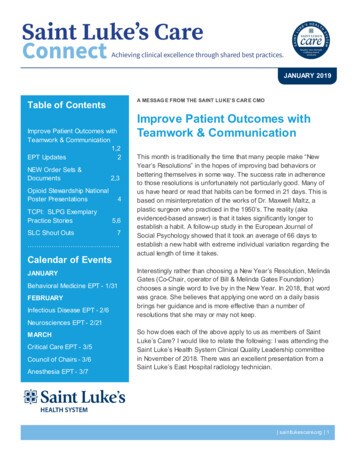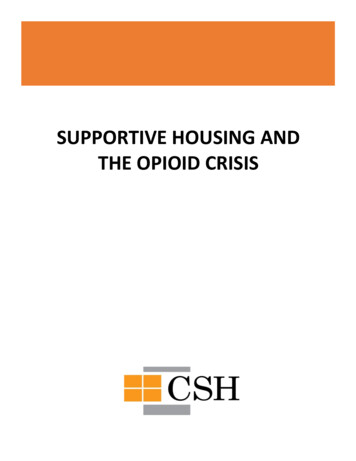
Transcription
SUPPORTIVE HOUSING ANDTHE OPIOID CRISIS
About CSH:CSH is the national champion for supportive housing, demonstrating its potential to improve the lives ofvery vulnerable individuals and families by helping communities create over 335,000 real homes. CSHfunding, expertise, and advocacy have provided 1 billion in direct loans and grants for supportive housingacross the country. Building on nearly 30 years of success developing multi and cross-sector partnerships,CSH engages broader systems to fully invest in solutions that drive equity, help people thrive, and harnessdata to generate concrete and sustainable results. By aligning affordable housing with services and othersectors, CSH helps communities move away from crisis, optimize their public resources, and ensure abetter future for everyone. Visit us at csh.org.Acknowledgements:CSH would like to thank Dr. Kelly Doran, Joloire Lauture, Shad Yasin, and Alejandro Ruiz for their assistancein preparing the survey and report.About this Report:CSH conducted a survey of supportive housing agencies across New York State to examine opioid use andoverdose among supportive housing tenants, and to identify what services and support agencies coulduse to better assist their tenants who have an opioid use disorder. This report outlines the following:I: PurposeII: IntroductionIII: MethodsIV: ResultsV: Discussion and RecommendationsAppendix1
Executive SummaryOpioid overdose continues to be a key health concern in the United States. There were 67,367 deaths dueto overdose in 2018 alone,1 with over two-thirds involving opioids.2 Past research has suggested thatpeople experiencing homelessness have above average risks for opioid overdose. 3 Drug overdose is nowa leading cause of death among people experiencing homelessness. 4 Less is known, however, about riskfor overdose among residents of permanent supportive housing. To begin to gather information on thistopic, the Corporation for Supportive Housing (CSH) conducted a survey of supportive housing agenciesacross New York State to examine opioid use and overdose among supportive housing tenants, and toidentify what services and support agencies could use to better assist their tenants who have an opioiduse disorder.This report compiles survey responses received from 49 supportive housing agencies, 25 in New York Cityand 24 from the rest of New York State. Overall, 65% of agencies surveyed reported feeling the opioidepidemic was a large or very large concern for their organization. Two-thirds of the agencies surveyedreported having opioid overdoses occurring at their supportive housing buildings in the past year,amounting to at least 142 suspected tenant opioid overdoses. Across all agencies that responded to thesurvey, at least 118 tenants had died of a suspected opioid overdose in the past five years, with 60% ofagencies responding to the survey reporting at least one death.Agencies varied in services they offered for tenants with opioid use disorder and in their preparedness torespond to a tenant overdose. Approximately one-third (35%) of agencies reported that less than half oftheir staff were trained to administer naloxone. Most agencies reported that their staff were at leastmoderately comfortable with tenants receiving medication for opioid use disorder (MOUD) such asmethadone and buprenorphine. Respondents cited barriers for tenants receiving MOUD and harmreduction services including stigma related to opioid use, insurance coverage, lack of provider availability,lack of transportation, perceived tenant readiness, and lack of provider education.Key Findings and Recommendations include:1. Two-thirds of agencies identified additional “training” as a resource that would be useful to betterserve tenants with opioid use disorder. Even agencies that already offered relatively robustservices to assist tenants with substance use requested and would benefit from additionaltrainings, specifically naloxone training.2. Permanent supportive housing providers require support in resolving practical barriers toassisting tenants in accessing MOUD such as lack of transportation and adequate treatmentprovider options. The COVID-19 pandemic has resulted in expansion of new models for substanceuse treatment, such as telehealth, that could help address some of these barriers. For example,NYC Health and Hospitals created a virtual buprenorphine clinic to continue to provide theirpatients treatment during the pandemic.53. Nearly one-quarter of agencies reported “stigma” to be a barrier preventing tenants fromreceiving harm reduction services or treatment including MOUD. Stigma is held not only by staffbut in many cases among tenants themselves. Providing additional education to staff /4 %20Background%20Reading%2020180219.pdf.)5 Virtual Buprenorphine Clinic NYC Health Hospitals (nychealthandhospitals.org)22
tenants on opioid use disorder, MOUD, and related stigma may foster an environment wherestaff are more likely to openly talk about these topics with tenants.I. PurposeThe goals of this survey and report were: To understand more about the landscape of permanent supportive housing tenant opioid use,overdose, and substance use treatment, as well as related services currently offered totenants; To identify barriers and gaps in connecting tenants with medication for opioid use disorder(MOUD) and other services; and, To develop recommendations for future initiatives to assist permanent supportive housingproviders and tenants in reducing risk of tenant overdose.II. IntroductionOpioid use and overdose continue to affect many across the country. According to the CDC, in 2018 alonethere were 67,367 drug overdose deaths in the U.S., with over two-thirds (69.5%) involving an opioid.1,2Drug overdose death rates increased in 35 of 50 states, plus the District of Columbia, from 2013 to 2017. 8Deaths involving synthetic opioids, such as fentanyl, continue to increase,1,2 due in part to increases in thepresence of fentanyl and its analogs in the last several years.9 Although the opioid epidemic is sometimesportrayed as an epidemic of middle class white suburban youth, rates of drug overdose involving fentanylare increasing most rapidly among non-Hispanic black Americans.10In New York City (NYC), fentanyl was the mostcommon substance involved in drug overdosedeaths in 2018. Of the total 1,444 unintentionaldrug overdose deaths reported in NYC in 2018,more than half (60%) involved fentanyl. Overdosedeaths involving fentanyl are disproportionatelyoccurring in residents of high povertyneighborhoods.11 Beyond NYC, opioid use andoverdose have affected many individuals across theentire state of New York. Statewide data showsthat from 2010 to 2017, deaths from all opioidsincreased 200%, from 1,074 to 3,224 yearly.12 Onceagain, synthetic opioids, specifically fentanyl, arethe primary driver of this increase. 12TerminologyOpioids: substances that interact with opioidreceptors on nerve cells in the body and brain toreduce intensity of pain signals. They can becategorized as natural (e.g. heroin, morphine),synthetic (e.g. methadone, fentanyl), or semisynthetic (e.g. oxycodone, hydromorphone) opioids.Opioids, whether illicit or prescription, can produceeuphoria in addition to pain relief and lead toaddiction, increasing the risk of overdose.19Naloxone (Narcan): a safe and effective drug thatcan be administered by anyone (not only health careproviders) to immediately reverse an opioid overdoseand prevent death.20MOUD (medication for opioid use disorder): longterm treatment option for opioid use disorder thatincludes methadone, buprenorphine (trade namesinclude Suboxone and Subutex), and naltrexone.These medications help decrease withdrawalsymptoms and cravings, and do not produce the samefeelings of euphoria that other opioids do. MOUDwas previously also known as “medication-assistedtreatment” or “MAT.” 21Studies have suggested that homelessness isassociated with a higher than average risk foropioid use and overdose.13 Homelessness is alsostrongly associated with known risk factors n, IDU, lack of access to MOUD, andprescription opioid misuse. Drug overdose is now the leading cause of death among individuals who arehomeless in New York City and other cities in which it has been examined. 4–7 While some elements of3
health may improve, the risk for overdose does not disappear once individuals are placed in permanentsupportive housing. Many supportive housing tenants have substance use disorders, including opioid usedisorder. Overall, little is known about rates of opioid use or overdose among supportive housing tenants,or about best practices for serving tenants with opioid use disorder. However, previous researchconducted in San Francisco has shown high rates of overdose deaths in single room occupancy buildings,which include supportive housing.14,15The Corporation for Supportive Housing (CSH), a national leader for solutions that use housing as aplatform for services to improve the lives of homeless individuals, developed an Addiction 101 webinarseries, in which providers can learn more about addiction related topics. CSH has hosted events in thepast like the Substance Use Treatment & Housing Forum, which bring together experts across the fieldsof substance use treatment, mental health, and supportive housing to promote discussions around findingnew ways to better serve individuals experiencing homelessness who have substance use disorders. CSHwishes to continue its work providing supportive housing providers with information and resources onhow to best serve tenants with opioid use disorder, including identifying and serving tenants who may beat risk for overdose. To gain a better understanding of current practices and the needs faced by supportivehousing agencies, CSH undertook a survey of supportive housing providers in New York.III. MethodsCSH conducted a survey of supportive housing provider agencies in New York State (NYS) to determinetheir experiences with tenant opioid use, overdose, receipt of treatment for opioid use disorder, andneeds related to the opioid crisis.The survey, consisting of 23 multiple choice and free answer questions, was sent via email to 160supportive housing agencies throughout NYS on October 29, 2019. Agencies were identified throughcomprehensive provider listings. All surveys were emailed to key contacts at each supportive housingagency. There were four survey reminders sent between October 29, 2019 and February 2020. The fullsurvey appears as Appendix 1 to this report. Agencies were asked how many supportive housing buildingsthey operated or served, and questions were answered at the agency level (i.e., not by individual facilityor building). Survey questions examined attitudes of agencies and their staff regarding the opioid crisis;status of opioid use and overdose among supportive housing tenants and visitors; agency preparednessin regard to opioid use and overdose; barriers in tenant use of MOUD; substance use related servicesoffered by the agencies; and resources agencies would find useful in serving tenants with opioid usedisorder.At the conclusion of the survey period, 52 completed surveys had been returned representing 49 differentagencies (30.6% response rate). The three duplicate responses for agencies that completed the surveytwice were consolidated by combining the free answer responses of each agency and considering only themost recent responses for the rest of the survey questions. We present aggregate results from the survey.IV. ResultsIn total, 49 unique permanent supportive housing provider agencies completed the survey; 25 agencieswere located in NYC and 24 were located in the rest of NYS. Of the agencies responding to the survey, 41operate scattered site units and 33 operate congregate (single site) units. There was an average of 261tenants served per agency, with a median of 164 tenants and a range of 0 to 2,300 tenants.4
Survey results are organized below by topic, including tenant opioid use and overdose, MOUD use in PSH,and substance use services and needs in supportive housing.TENANT OPIOID USE AND OVERDOSEOverall, 65.3% of respondents reported that the opioid epidemic was a very large or large concern fortheir agency’s supportive housing work.How much of a concern is the opioid epidemic foryour agency's supportive housing work?Percent of total %0.0%0%Very largeconcernLarge concernModerateconcernMinimal concernNo concernFigure 1Tenant use of opioidsAgencies were asked to approximate what percentage of their agency’s total supportive housing tenants“used illicit opioids including heroin, fentanyl, or prescription opioids other than as prescribed?” 6 Of theagencies that responded to this question (n 48), 21 (43.8%) estimated that 1-10% of their tenants usedillicit opioids, 21 (43.8%) estimated that 11-50% of their tenants used them, and three (6.3%) estimatedthat over 50% of their tenants used them. Further details are shown in Figure 2.6The majority of agencies provided a response representing a full integer percentage. Four agencies provided irregular responses including“ 30%”, “below 5%”, “less than 10%”, and “less than 1%”, which were consolidated and included in data as “29%”, “4%”, “9%”, and “0%”,respectively. One agency responded with “we do not track this,” resulting in total of 48 responses for this question.5
Percentage of total tenants estimated to use illicitopioidsPercent of re 2Past year opioid overdoseAgencies were asked to estimate the total number of fatal and nonfatal suspected overdoses involvingopioids among their supportive housing tenants in the past year. Agencies were instructed to include anyoverdose that may have involved opioids, even if other drugs were involved too, and to count eachepisode separately if the same tenant had more than one overdose.Overall, 31 (63.3%) agencies reported at least oneopioid-involved overdose among supportive housingtenants in the past year. Across agencies respondingthat there was an overdose, at least 142 suspectedopioid-involved overdoses were reported, includingfatal and nonfatal, among tenants in the past year. 7In the past year, at least 142suspectedopioid-involvedoverdoses, fatal and nonfatal,occurred among supportivehousing tenants across theresponding agencies (n 46).Overall, 23 (47.9%) agencies reported between 1-5opioid-involved overdoses among tenants in thepast year, while eight (16.7%) agencies reportedmore than five overdoses among their tenants in the past year. Overall, overdose appears unequallydistributed across agencies, with approximately one-third of agencies (n 17, 35.4%) reporting no tenantoverdose in the past year but four agencies (8.3%) reporting over 10 tenant overdoses in the past year.Past year opioid overdoses among non-residentsAgencies were also asked to estimate the total number of fatal and nonfatal suspected overdosesinvolving opioids among non-residents (visitors, etc.) in their agency’s facilities in the past year. Across all7 Three agencies reported “ 5,” “10%,” and “0.02%”and therefore could not be included in the total overdose count calculation but areincluded in the count of agencies reporting at least one opioid overdose. The agencies reporting “ 5” and “0.02%” are included in the 1 to 5overdose category (the agency reporting “0.02%” clarified there was at least one overdose). The agency reporting “10%” is not included in thecategorical calculations.6
agencies surveyed, 64 suspected overdoses involving opioids occurred among non-residents in supportivehousing buildings in the past year. Twenty (40.8%) agencies reported at least one overdose involvingopioids among non-residents (Figure 4).Suspected overdose involving opiods amongnon-residents (past year)Percent of -10Number of overdosesFigure 4Overdose locationSurvey respondents were asked where tenant overdoses had occurred, and they selected pre-specifiedlocation types from a list or wrote in other locations. “Tenant apartment” was the most commonlyreported location for tenant opioid overdose, with 31 agencies reporting opioid overdoses occurring inthis location. This location was followed by “outside the grounds of the supportive housing building” (11agencies), “other supportive housing common areas” (six agencies), “sidewalk or other outside areacontiguous to the supportive housing building” (six agencies), and “supportive housing building lobbies”(three agencies). Additional locations written in by five respondents included “friend’s house,” “in store,”“outside near office locations,” “hospital,” and “at client's mother's home and at [a] harm reductionagency.” Ten agencies did not provide a location and indicated there were no reported overdoses at theiragency or indicated “N/A” as a response.Naloxone administrationAgencies were asked to approximate how many times naloxone (NarcanTM) had been administered by astaff member at their facilities in the past year. Across all agencies surveyed, naloxone had beenadministered 37 times by a staff member at a supportive housing facility in the past year. Overall, 40(81.6%) agencies reported never administering naloxone, three (6.1%) reported one use, two (4.1%)reported two uses, one (2.0%) reported three uses, one (2.0%) reported five uses, one (2.0%) reportedseven uses, and one (2.0%) reported 15 uses.7
EMS response for opioid overdoseSurvey respondents were asked to approximate how many times emergency medical services (EMS) hadbeen called to their supportive housing facilities for a suspected opioid overdose in the past year. Acrossall 45 agencies who responded, 8 EMS has been called a total of 164 times to supportive housing facilitiesfor a suspected opioid overdose, an average of 3.6 times per agency. Categorizing the responses, 21(45.7%) of the 46 agencies who answered this question reported never calling EMS, five (10.9%) reportedcalling EMS one time, four (8.7%) called 2-3 times, five (10.9%) called 4-5 times, six (13.0%) called 6-10times, three (6.5%) called 11-15 times, and two (4.3%) called 20-25 times.Deaths from overdoseIn the past five years across 46 agencies responding, at least118 permanent supportive housing tenants were reported tohave died after suspected overdose involving opioids.9Overall, 29 (60.4%) agencies reported at least one death inthe past five years after a suspected opioid-involvedoverdose. Four (8.7%) agencies reported 10 or more deathsinvolving opioids, with one agency reporting 30 deaths in thepast five years.In the past five yearsacross 46 agencies, 118tenants had died aftera suspected overdoseinvolving opioids.MEDICATION FOR OPIOID USE DISORDER (MOUD) IN SUPPORTIVE HOUSINGMethadone and buprenorphine acceptance in supportive housingSurvey respondents were asked if their supportive housing agency allowed tenants who are takingmethadone and buprenorphine to treat opioid use disorder (OUD). All 49 agencies responding to thesurvey reported that they accepted tenants who were taking methadone, though two (4.1%) reportedallowing tenants who were taking methadone at only some of their buildings. Similarly, all 49 supportivehousing agencies reported allowing tenants who were taking buprenorphine (Suboxone), though two(4.1%) allowed this at only some of their facilities.Staff comfort with tenant use of MOUDAgencies were asked to estimate the comfort level of their staff with tenants who take MOUD, includingmethadone and buprenorphine (Suboxone). Overall, 28 (57.1%) respondents reported that their staffwere “very comfortable” or “extremely comfortable” with tenants who use medications for opioid usedisorder (Figure 5).8One agency reported “ 10” and therefore could not be included in the total and mean calculations but is included in the 6 to 10 category inthe categorical analysis.9 Most agencies provided a response representing a full integer. One agency provided a percentage, “10%”, instead of a full integer as aresponse; 10% of the agency’s total tenants would have been 30 but given ambiguity about what “10%” referred to results are only reportedas “at least one overdose death” and not included in count or categorical calculations. The second irregular response provided was “ 10” whichwas not included in the total count of overdoses or categorical calculations but is included in the count of agencies reporting at least oneoverdose death. One agency did not provide a response to this question and is not included.8
Staff comfort level with tenants who take MOUD40%32.7%Percent of agecies35%34.7%30%25%22.4%20%15%8.2%10%5%2.0%0%Not at ableVerycomfortableExtremelycomfortableFigure 5Agencies were asked to elaborate on their response to this question. Agencies that reported their staffbeing “not at all comfortable” stated this was because none of their clients use opioids as far as they areaware and as a result they have no practical experience with tenants using MOUD and noted budgetaryconcerns to “support the more highly skilled staff that we would need if we were to have a sudden influxof clients dealing with opioid addiction.” Agencies that reported their staff to be “slightly comfortable”noted that staff have “varying degrees of understanding” in regards to MOUD and that more training wasneeded for their staff on this topic.Agencies that reported their staff to be “moderately comfortable” elaborated on their responses withvarying sentiments. One agency reported that staff members were comfortable working with tenantstaking MOUD as a result of multiple years of experience. Others stated that their agencies promoted a“harm reduction” approach with tenants. Regardless of the reason behind their comfort level, multipleagencies (n 4) reported that they are open to additional trainings for their staff. Notably, some agenciesreported that tenant use of MOUD can be a controversial topic with certain staff members. One agencystated, “Some staff continue to struggle with the concept of MAT [MOUD] in addiction treatment whenthey observe the addictive/abusive behavior carry over to the MAT [MOUD] substance.” Another agencyreported, “ There is a mix of opinions on MAT [MOUD] and how it relates to sobriety.”Agencies that reported staff were “very comfortable” with tenants who take MOUD noted that their staffwere well trained on the topic of harm reduction and treatment options for substance use disorder, andas a result staff had little concerns working with tenants who were taking MOUD. Notable responsesincluded, “We provide ongoing training on Harm Reduction and substance use agency-wide so housingstaff are very comfortable working with people who use MAT [MOUD].” Another agency stated, “Staffhave been educated on the benefits of our consumers seeking out and receiving MAT [MOUD] Services.There have been no reports of staff feeling uncomfortable regarding this area of service.” However, oneagency did report, “Generally staff [are] very comfortable, but we have one or two members that believeMAT [MOUD] is not effective. Quite a few of our residents are using illicit substances along with their MAT[MOUD].”9
Agencies that stated their staff were “extremely comfortable” with tenants taking MOUD also creditedsuccessful staff training and years of experience with this tenant population. Many agencies also reporteda positive sentiment towards MOUD by noting that they believed they were “effective” and “safe.”Further, one agency stated, “We have a CASAC [Credentialed Alcoholism and Substance Abuse Counselor]on our staff that works directly with the residents We receive internal trainings on engaging individualswith substance use in housing.” Another agency elaborated, “Our staff understands the benefit that MAT[MOUD] has for some individuals. We are happy that those we serve are putting in the work to accomplishtheir goals and we will be here to assist them in any way we can.”OTHER OPIOID USE SERVICES AND NEEDS IN SUPPORTIVE HOUSINGNaloxone use staff preparednessAgencies were asked to approximate what percentage of their staff working at supportive housingbuildings or with supportive housing tenants are trained in the use of naloxone to reverse an opioidoverdose. Overall, 18 (36.7%) agencies reported that over 90% of their staff are trained in the use ofnaloxone to reverse an opioid overdose, though a significant number of agencies had fewer staff trained(Figure 6).Percentage of supportive housing staff trained inusing naloxone for opioid overdose, by agency40%36.7%Percent of 6.1%11-30%31-50%5%0%0%1-10%51-70%71-90%over 90%Percentage of staff per ageny trained in naloxone useFigure 6Services offered to supportive housing tenants with OUDAgencies were asked what services they offered for tenants with opioid used disorder (OUD) by selectingservices from a list or writing in other services. Most agencies offered referrals to various substance useservices: 45 (91.8%) agencies offered referrals to outpatient substance use programs, 43 (87.8%) offeredreferrals to inpatient substance use programs, 37 (75.5%) offered referrals to 12-step programs, and 30(61.2%) offered referrals to MOUD (MAT).10
Fewer agencies reported onsite services for OUD: 23 (46.9%) reported offering harm reduction services,21 (42.9%) offered groups/counseling for substance use, and six (12.2%) had visiting physicians or nursepractitioners for OUD treatment/MOUD. Other services offered provided as free response answersincluded medical students providing medical related outreach twice monthly onsite, “onsite groups andprogramming from community service agencies and stakeholders,” and referrals to Health Home caremanagers.Agencies were also asked whether they had a memorandum of understanding (MOU) with serviceproviders for MOUD, harm reduction, or addiction treatment. Of the agencies responding, 25 (51.0%)reported having a MOU with any addiction treatment program, 22 (44.9%) had a MOU with any harmreduction program, and 13 (26.5%) had a MOU with any MOUD program. Fewer agencies noted otherrelevant MOUs including with a medical van and medical center. Two agencies noted that they had theirown harm reduction programming. Some agencies without MOUs wrote in further explanation such as,“our housing program staff are trained in harm reduction approach and we have several communityproviders in the neighborhood,” “there is no explicit document that outlines the available services, butstaff is aware of the resources and educates their clients about these resources when appropriate,” and“we are exploring options for MOUs for all of the above.”Supporting tenants who have opioid use disorderRespondents were asked a free response question about how their agency supported tenants who haveopioid use disorder and other substance use disorders. The question specified that support could includeservices offered to tenants, staff trainings, and other such supports. Thirty (61.2%) agencies volunteeredthat they provided support in the form of trainings. These trainings included harm reduction training,naloxone training for staff and tenants, and trainings on the topic of substance use disorder and MOUD.One agency elaborated on how they used trainings and other resources to support their tenants, stating,“We are constantly training our staff to increase their knowledge base about addiction in order to betterunderstand this disease so that they can support our tenants through their addiction journey. Thisincludes, but [is] not limited to Trauma Informed Care, Harm Reduction, DBT, Wellness Self-Managementand trainings about treatment options. Most importantly, we offer an environment where tenants feelcomfortable discussing their addictions and know that they are not being judged.”Approximately one-third of agencies volunteered that they support their tenants by providing referrals totreatment providers, detox and rehabilitation facilities, and substance use counseling. One agencyelaborated, “Referrals for clean needles, available sharps containers, supportive counseling, onsitepsychiatry, harm reduction trainings, wellness groups, informational flyers and referrals to detox andinpatient treatment.” Two agencies also stated that they have memorandums of understanding withmultiple community organizations that are able to provide a variety of services including MOUD.Other ways in which agencies stated they support tenants with substance use disorders included peersupport resources in the form of peer support groups, recovery and empowerment groups, wellnessgroups, and sober support networks. One agency elaborated on this form of support: “We operate a trueHousing First model apartment program that provides a home to individuals regardless of where they arein treatment. We also have a Dual Recovery program with groups three times a week, peer supportservices and social connections to provide a healthy and sober support network for those seekingassistance. We also have close relationships with [substance use treatment] providers in our areaproviding a warm hand off and working together to best help those we serve.”11
Several agencies also stated they provide tenants with supportive counseling, social work counseling, oneon-one counseling, and substance use counseling. Other agencies stated that they provide workshops andNA (Narcotics Anonymous) meetings for their tenants. A few agencies noted their connection with mentalhealth and servic
conducted in San Francisco has shown high rates of overdose deaths in single room occupancy buildings, which include supportive housing.14,15 The Corporation for Supportive Housing (CSH), a national leader for solutions that use housing as a platform for services to improve the lives of homeless individuals, developed an Addiction 101 webinar


